Explaining Culinary Tourism and Its Links with Cultural Tourism and Its Importance
VerifiedAdded on 2023/06/11
|10
|3692
|453
AI Summary
This report explains the meaning of culinary tourism and its links with cultural tourism. It outlines the importance of cultural tourism and its holistic benefits. The report covers the growth of culinary tourism, its market growth, and the rise of unique and exotic holiday destinations. It also covers the importance of cultural tourism in strengthening the competitiveness and attractiveness of places and countries. Subject: TLH 334 Gastronomy
Contribute Materials
Your contribution can guide someone’s learning journey. Share your
documents today.
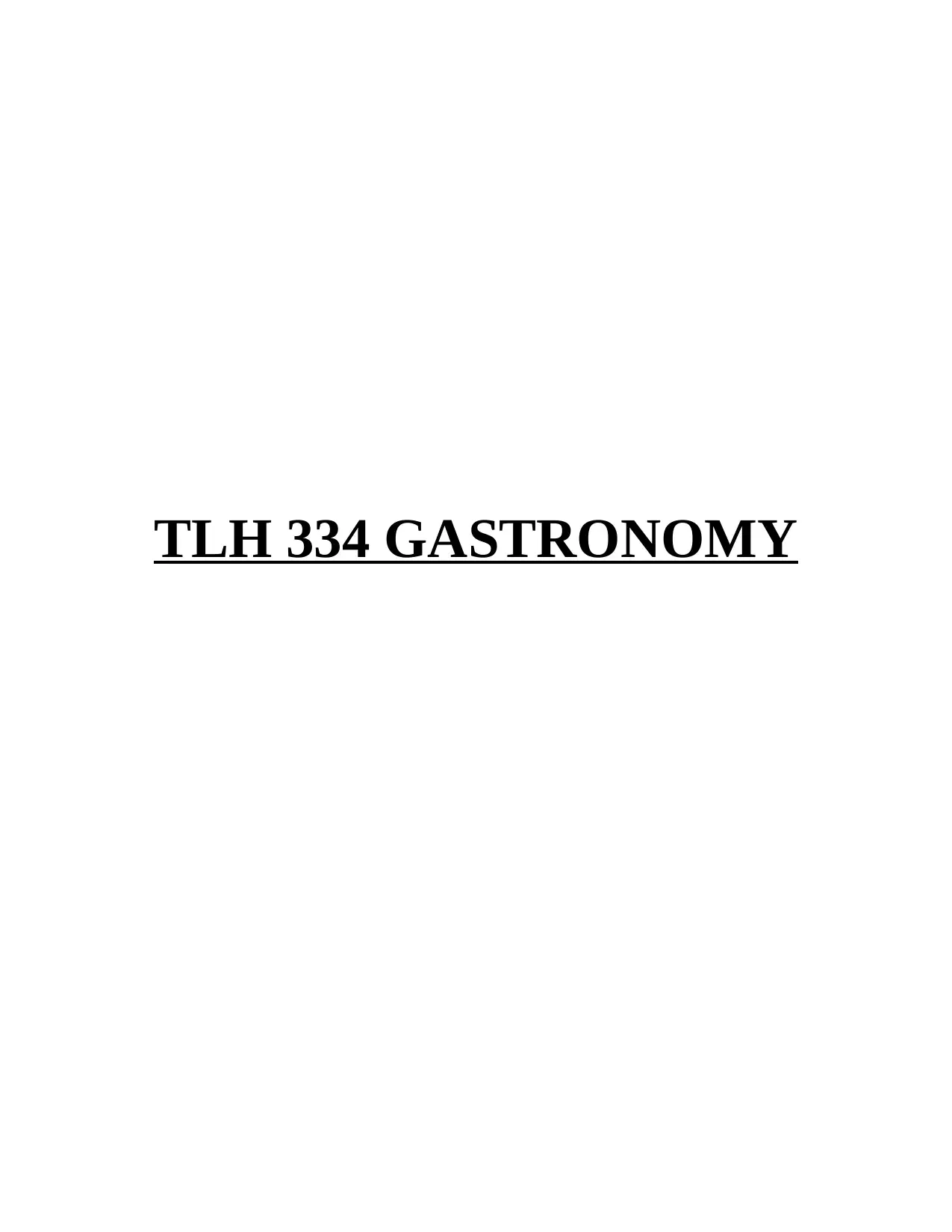
TLH 334 GASTRONOMY
Secure Best Marks with AI Grader
Need help grading? Try our AI Grader for instant feedback on your assignments.
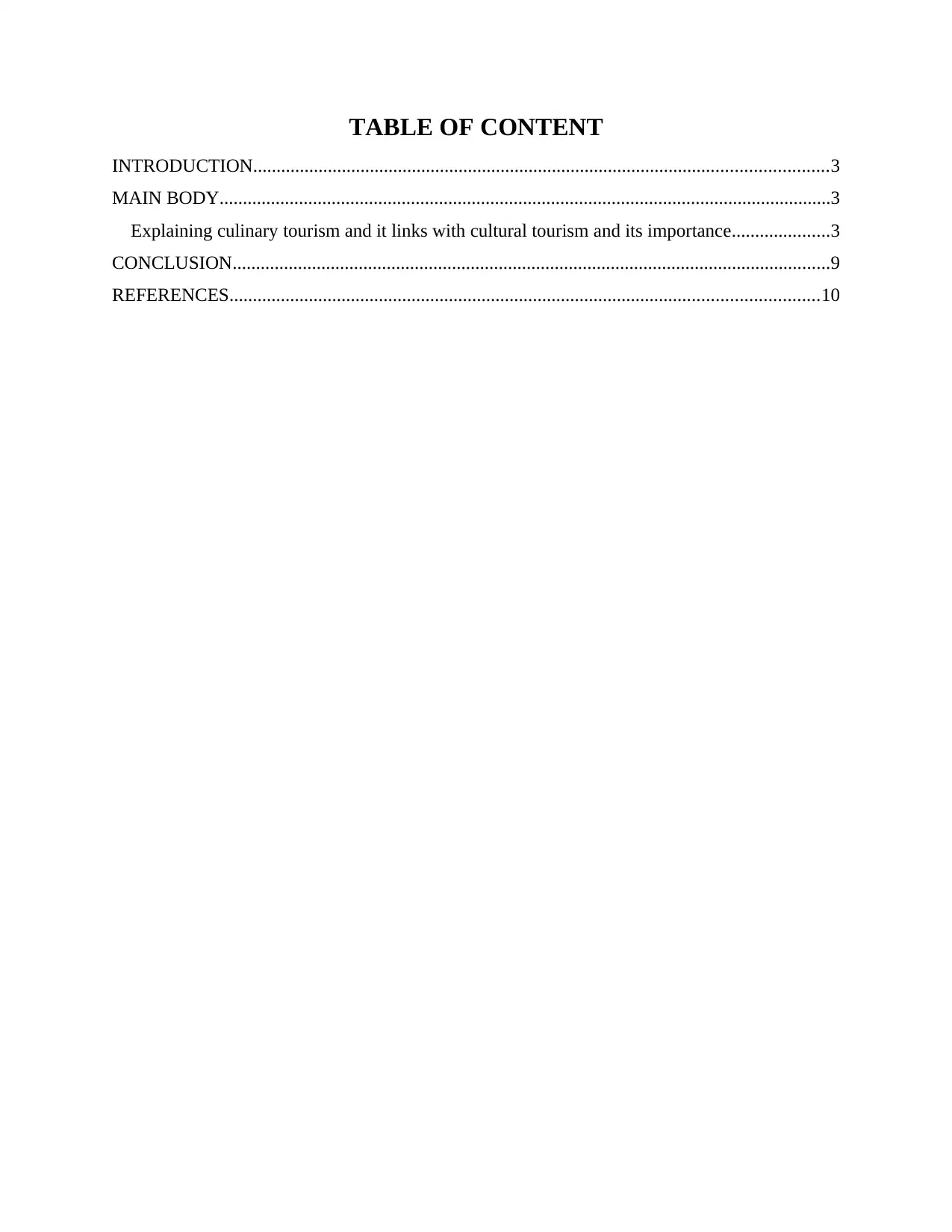
TABLE OF CONTENT
INTRODUCTION...........................................................................................................................3
MAIN BODY...................................................................................................................................3
Explaining culinary tourism and it links with cultural tourism and its importance.....................3
CONCLUSION................................................................................................................................9
REFERENCES..............................................................................................................................10
INTRODUCTION...........................................................................................................................3
MAIN BODY...................................................................................................................................3
Explaining culinary tourism and it links with cultural tourism and its importance.....................3
CONCLUSION................................................................................................................................9
REFERENCES..............................................................................................................................10
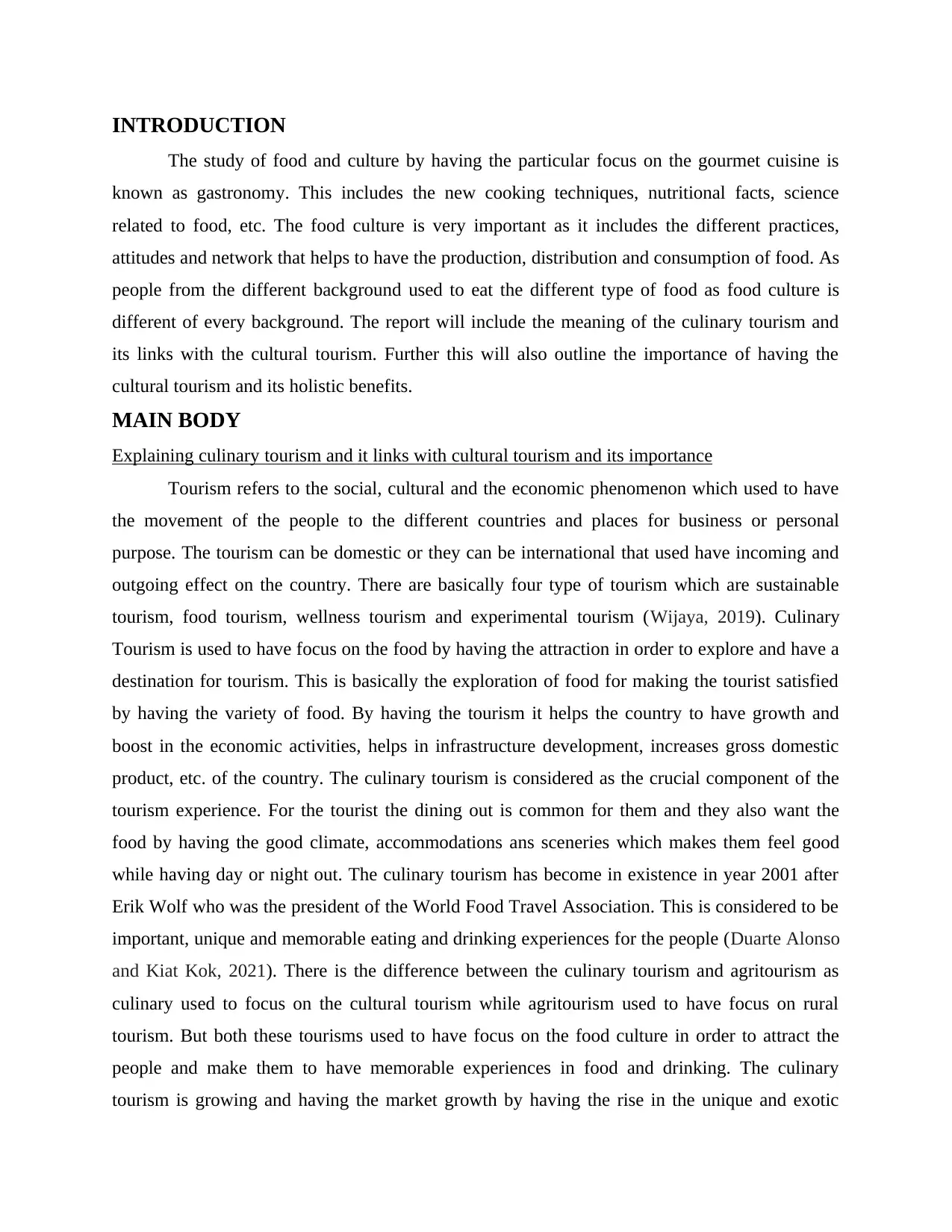
INTRODUCTION
The study of food and culture by having the particular focus on the gourmet cuisine is
known as gastronomy. This includes the new cooking techniques, nutritional facts, science
related to food, etc. The food culture is very important as it includes the different practices,
attitudes and network that helps to have the production, distribution and consumption of food. As
people from the different background used to eat the different type of food as food culture is
different of every background. The report will include the meaning of the culinary tourism and
its links with the cultural tourism. Further this will also outline the importance of having the
cultural tourism and its holistic benefits.
MAIN BODY
Explaining culinary tourism and it links with cultural tourism and its importance
Tourism refers to the social, cultural and the economic phenomenon which used to have
the movement of the people to the different countries and places for business or personal
purpose. The tourism can be domestic or they can be international that used have incoming and
outgoing effect on the country. There are basically four type of tourism which are sustainable
tourism, food tourism, wellness tourism and experimental tourism (Wijaya, 2019). Culinary
Tourism is used to have focus on the food by having the attraction in order to explore and have a
destination for tourism. This is basically the exploration of food for making the tourist satisfied
by having the variety of food. By having the tourism it helps the country to have growth and
boost in the economic activities, helps in infrastructure development, increases gross domestic
product, etc. of the country. The culinary tourism is considered as the crucial component of the
tourism experience. For the tourist the dining out is common for them and they also want the
food by having the good climate, accommodations ans sceneries which makes them feel good
while having day or night out. The culinary tourism has become in existence in year 2001 after
Erik Wolf who was the president of the World Food Travel Association. This is considered to be
important, unique and memorable eating and drinking experiences for the people (Duarte Alonso
and Kiat Kok, 2021). There is the difference between the culinary tourism and agritourism as
culinary used to focus on the cultural tourism while agritourism used to have focus on rural
tourism. But both these tourisms used to have focus on the food culture in order to attract the
people and make them to have memorable experiences in food and drinking. The culinary
tourism is growing and having the market growth by having the rise in the unique and exotic
The study of food and culture by having the particular focus on the gourmet cuisine is
known as gastronomy. This includes the new cooking techniques, nutritional facts, science
related to food, etc. The food culture is very important as it includes the different practices,
attitudes and network that helps to have the production, distribution and consumption of food. As
people from the different background used to eat the different type of food as food culture is
different of every background. The report will include the meaning of the culinary tourism and
its links with the cultural tourism. Further this will also outline the importance of having the
cultural tourism and its holistic benefits.
MAIN BODY
Explaining culinary tourism and it links with cultural tourism and its importance
Tourism refers to the social, cultural and the economic phenomenon which used to have
the movement of the people to the different countries and places for business or personal
purpose. The tourism can be domestic or they can be international that used have incoming and
outgoing effect on the country. There are basically four type of tourism which are sustainable
tourism, food tourism, wellness tourism and experimental tourism (Wijaya, 2019). Culinary
Tourism is used to have focus on the food by having the attraction in order to explore and have a
destination for tourism. This is basically the exploration of food for making the tourist satisfied
by having the variety of food. By having the tourism it helps the country to have growth and
boost in the economic activities, helps in infrastructure development, increases gross domestic
product, etc. of the country. The culinary tourism is considered as the crucial component of the
tourism experience. For the tourist the dining out is common for them and they also want the
food by having the good climate, accommodations ans sceneries which makes them feel good
while having day or night out. The culinary tourism has become in existence in year 2001 after
Erik Wolf who was the president of the World Food Travel Association. This is considered to be
important, unique and memorable eating and drinking experiences for the people (Duarte Alonso
and Kiat Kok, 2021). There is the difference between the culinary tourism and agritourism as
culinary used to focus on the cultural tourism while agritourism used to have focus on rural
tourism. But both these tourisms used to have focus on the food culture in order to attract the
people and make them to have memorable experiences in food and drinking. The culinary
tourism is growing and having the market growth by having the rise in the unique and exotic
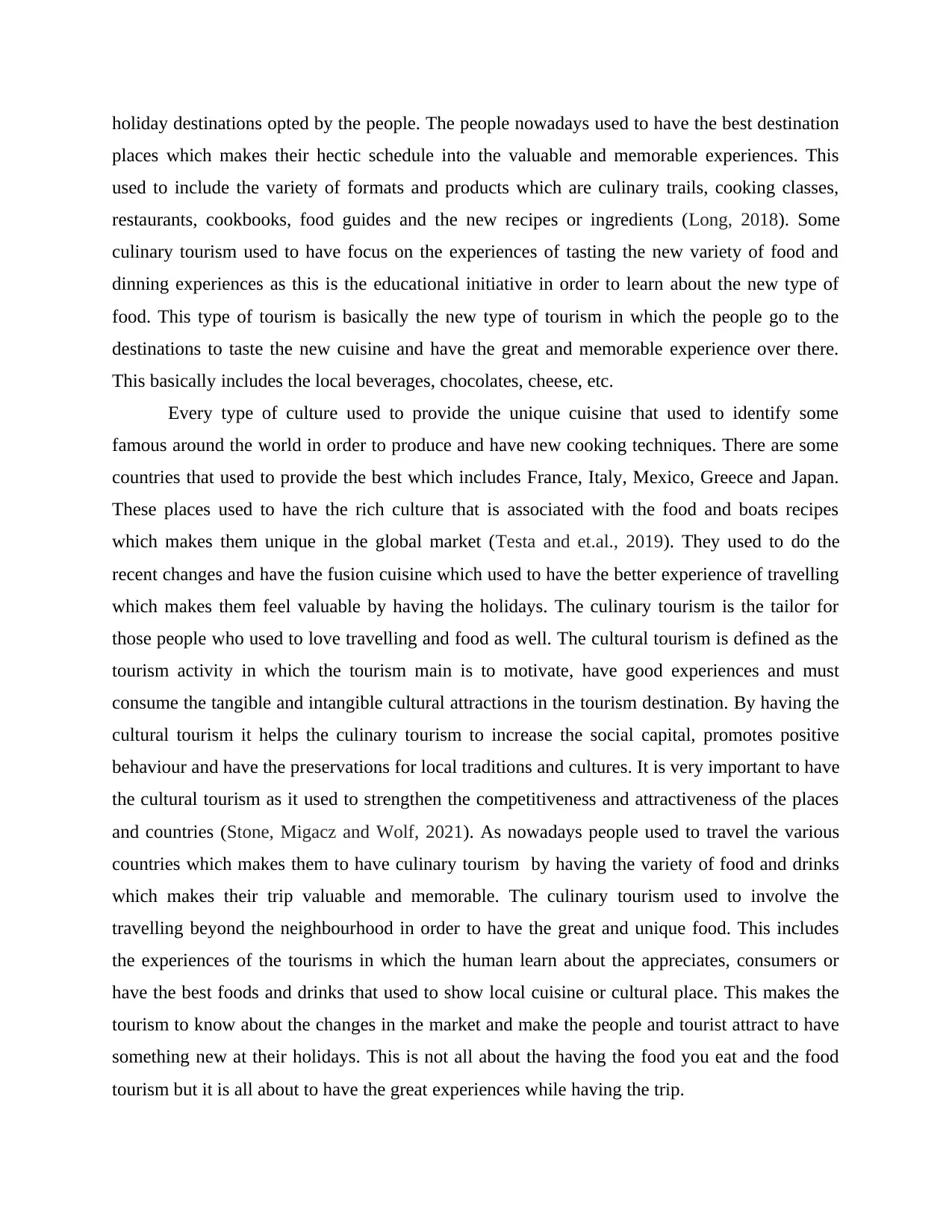
holiday destinations opted by the people. The people nowadays used to have the best destination
places which makes their hectic schedule into the valuable and memorable experiences. This
used to include the variety of formats and products which are culinary trails, cooking classes,
restaurants, cookbooks, food guides and the new recipes or ingredients (Long, 2018). Some
culinary tourism used to have focus on the experiences of tasting the new variety of food and
dinning experiences as this is the educational initiative in order to learn about the new type of
food. This type of tourism is basically the new type of tourism in which the people go to the
destinations to taste the new cuisine and have the great and memorable experience over there.
This basically includes the local beverages, chocolates, cheese, etc.
Every type of culture used to provide the unique cuisine that used to identify some
famous around the world in order to produce and have new cooking techniques. There are some
countries that used to provide the best which includes France, Italy, Mexico, Greece and Japan.
These places used to have the rich culture that is associated with the food and boats recipes
which makes them unique in the global market (Testa and et.al., 2019). They used to do the
recent changes and have the fusion cuisine which used to have the better experience of travelling
which makes them feel valuable by having the holidays. The culinary tourism is the tailor for
those people who used to love travelling and food as well. The cultural tourism is defined as the
tourism activity in which the tourism main is to motivate, have good experiences and must
consume the tangible and intangible cultural attractions in the tourism destination. By having the
cultural tourism it helps the culinary tourism to increase the social capital, promotes positive
behaviour and have the preservations for local traditions and cultures. It is very important to have
the cultural tourism as it used to strengthen the competitiveness and attractiveness of the places
and countries (Stone, Migacz and Wolf, 2021). As nowadays people used to travel the various
countries which makes them to have culinary tourism by having the variety of food and drinks
which makes their trip valuable and memorable. The culinary tourism used to involve the
travelling beyond the neighbourhood in order to have the great and unique food. This includes
the experiences of the tourisms in which the human learn about the appreciates, consumers or
have the best foods and drinks that used to show local cuisine or cultural place. This makes the
tourism to know about the changes in the market and make the people and tourist attract to have
something new at their holidays. This is not all about the having the food you eat and the food
tourism but it is all about to have the great experiences while having the trip.
places which makes their hectic schedule into the valuable and memorable experiences. This
used to include the variety of formats and products which are culinary trails, cooking classes,
restaurants, cookbooks, food guides and the new recipes or ingredients (Long, 2018). Some
culinary tourism used to have focus on the experiences of tasting the new variety of food and
dinning experiences as this is the educational initiative in order to learn about the new type of
food. This type of tourism is basically the new type of tourism in which the people go to the
destinations to taste the new cuisine and have the great and memorable experience over there.
This basically includes the local beverages, chocolates, cheese, etc.
Every type of culture used to provide the unique cuisine that used to identify some
famous around the world in order to produce and have new cooking techniques. There are some
countries that used to provide the best which includes France, Italy, Mexico, Greece and Japan.
These places used to have the rich culture that is associated with the food and boats recipes
which makes them unique in the global market (Testa and et.al., 2019). They used to do the
recent changes and have the fusion cuisine which used to have the better experience of travelling
which makes them feel valuable by having the holidays. The culinary tourism is the tailor for
those people who used to love travelling and food as well. The cultural tourism is defined as the
tourism activity in which the tourism main is to motivate, have good experiences and must
consume the tangible and intangible cultural attractions in the tourism destination. By having the
cultural tourism it helps the culinary tourism to increase the social capital, promotes positive
behaviour and have the preservations for local traditions and cultures. It is very important to have
the cultural tourism as it used to strengthen the competitiveness and attractiveness of the places
and countries (Stone, Migacz and Wolf, 2021). As nowadays people used to travel the various
countries which makes them to have culinary tourism by having the variety of food and drinks
which makes their trip valuable and memorable. The culinary tourism used to involve the
travelling beyond the neighbourhood in order to have the great and unique food. This includes
the experiences of the tourisms in which the human learn about the appreciates, consumers or
have the best foods and drinks that used to show local cuisine or cultural place. This makes the
tourism to know about the changes in the market and make the people and tourist attract to have
something new at their holidays. This is not all about the having the food you eat and the food
tourism but it is all about to have the great experiences while having the trip.
Secure Best Marks with AI Grader
Need help grading? Try our AI Grader for instant feedback on your assignments.
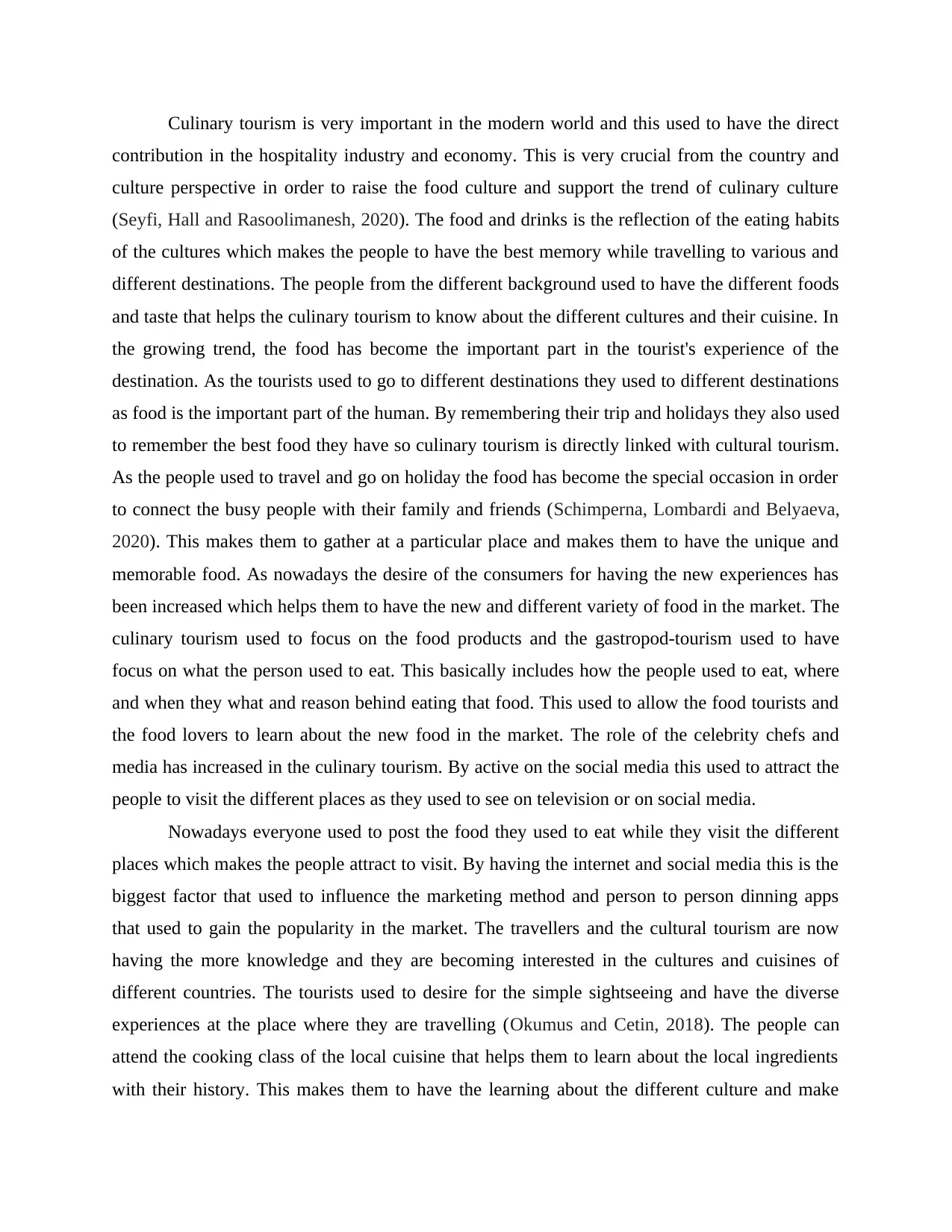
Culinary tourism is very important in the modern world and this used to have the direct
contribution in the hospitality industry and economy. This is very crucial from the country and
culture perspective in order to raise the food culture and support the trend of culinary culture
(Seyfi, Hall and Rasoolimanesh, 2020). The food and drinks is the reflection of the eating habits
of the cultures which makes the people to have the best memory while travelling to various and
different destinations. The people from the different background used to have the different foods
and taste that helps the culinary tourism to know about the different cultures and their cuisine. In
the growing trend, the food has become the important part in the tourist's experience of the
destination. As the tourists used to go to different destinations they used to different destinations
as food is the important part of the human. By remembering their trip and holidays they also used
to remember the best food they have so culinary tourism is directly linked with cultural tourism.
As the people used to travel and go on holiday the food has become the special occasion in order
to connect the busy people with their family and friends (Schimperna, Lombardi and Belyaeva,
2020). This makes them to gather at a particular place and makes them to have the unique and
memorable food. As nowadays the desire of the consumers for having the new experiences has
been increased which helps them to have the new and different variety of food in the market. The
culinary tourism used to focus on the food products and the gastropod-tourism used to have
focus on what the person used to eat. This basically includes how the people used to eat, where
and when they what and reason behind eating that food. This used to allow the food tourists and
the food lovers to learn about the new food in the market. The role of the celebrity chefs and
media has increased in the culinary tourism. By active on the social media this used to attract the
people to visit the different places as they used to see on television or on social media.
Nowadays everyone used to post the food they used to eat while they visit the different
places which makes the people attract to visit. By having the internet and social media this is the
biggest factor that used to influence the marketing method and person to person dinning apps
that used to gain the popularity in the market. The travellers and the cultural tourism are now
having the more knowledge and they are becoming interested in the cultures and cuisines of
different countries. The tourists used to desire for the simple sightseeing and have the diverse
experiences at the place where they are travelling (Okumus and Cetin, 2018). The people can
attend the cooking class of the local cuisine that helps them to learn about the local ingredients
with their history. This makes them to have the learning about the different culture and make
contribution in the hospitality industry and economy. This is very crucial from the country and
culture perspective in order to raise the food culture and support the trend of culinary culture
(Seyfi, Hall and Rasoolimanesh, 2020). The food and drinks is the reflection of the eating habits
of the cultures which makes the people to have the best memory while travelling to various and
different destinations. The people from the different background used to have the different foods
and taste that helps the culinary tourism to know about the different cultures and their cuisine. In
the growing trend, the food has become the important part in the tourist's experience of the
destination. As the tourists used to go to different destinations they used to different destinations
as food is the important part of the human. By remembering their trip and holidays they also used
to remember the best food they have so culinary tourism is directly linked with cultural tourism.
As the people used to travel and go on holiday the food has become the special occasion in order
to connect the busy people with their family and friends (Schimperna, Lombardi and Belyaeva,
2020). This makes them to gather at a particular place and makes them to have the unique and
memorable food. As nowadays the desire of the consumers for having the new experiences has
been increased which helps them to have the new and different variety of food in the market. The
culinary tourism used to focus on the food products and the gastropod-tourism used to have
focus on what the person used to eat. This basically includes how the people used to eat, where
and when they what and reason behind eating that food. This used to allow the food tourists and
the food lovers to learn about the new food in the market. The role of the celebrity chefs and
media has increased in the culinary tourism. By active on the social media this used to attract the
people to visit the different places as they used to see on television or on social media.
Nowadays everyone used to post the food they used to eat while they visit the different
places which makes the people attract to visit. By having the internet and social media this is the
biggest factor that used to influence the marketing method and person to person dinning apps
that used to gain the popularity in the market. The travellers and the cultural tourism are now
having the more knowledge and they are becoming interested in the cultures and cuisines of
different countries. The tourists used to desire for the simple sightseeing and have the diverse
experiences at the place where they are travelling (Okumus and Cetin, 2018). The people can
attend the cooking class of the local cuisine that helps them to learn about the local ingredients
with their history. This makes them to have the learning about the different culture and make
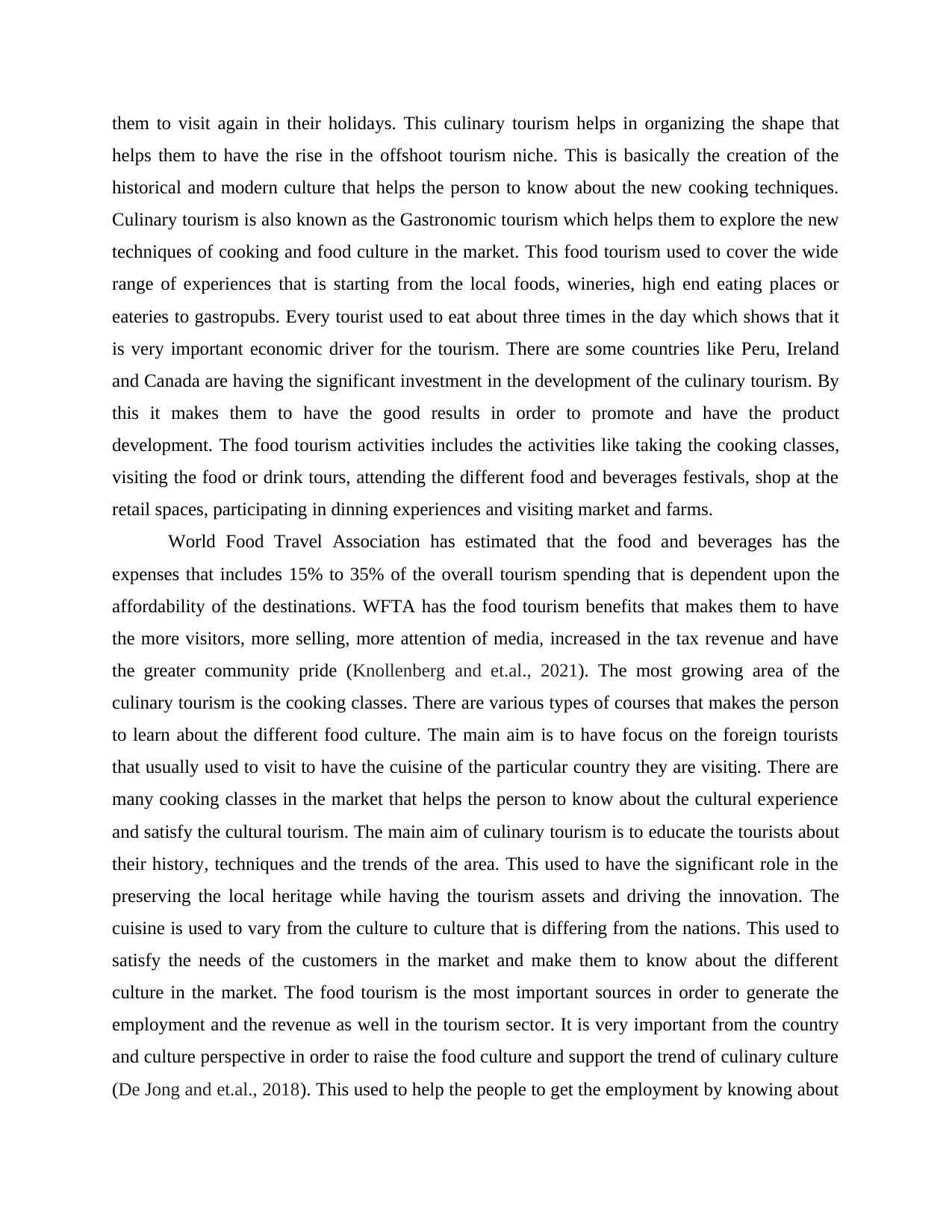
them to visit again in their holidays. This culinary tourism helps in organizing the shape that
helps them to have the rise in the offshoot tourism niche. This is basically the creation of the
historical and modern culture that helps the person to know about the new cooking techniques.
Culinary tourism is also known as the Gastronomic tourism which helps them to explore the new
techniques of cooking and food culture in the market. This food tourism used to cover the wide
range of experiences that is starting from the local foods, wineries, high end eating places or
eateries to gastropubs. Every tourist used to eat about three times in the day which shows that it
is very important economic driver for the tourism. There are some countries like Peru, Ireland
and Canada are having the significant investment in the development of the culinary tourism. By
this it makes them to have the good results in order to promote and have the product
development. The food tourism activities includes the activities like taking the cooking classes,
visiting the food or drink tours, attending the different food and beverages festivals, shop at the
retail spaces, participating in dinning experiences and visiting market and farms.
World Food Travel Association has estimated that the food and beverages has the
expenses that includes 15% to 35% of the overall tourism spending that is dependent upon the
affordability of the destinations. WFTA has the food tourism benefits that makes them to have
the more visitors, more selling, more attention of media, increased in the tax revenue and have
the greater community pride (Knollenberg and et.al., 2021). The most growing area of the
culinary tourism is the cooking classes. There are various types of courses that makes the person
to learn about the different food culture. The main aim is to have focus on the foreign tourists
that usually used to visit to have the cuisine of the particular country they are visiting. There are
many cooking classes in the market that helps the person to know about the cultural experience
and satisfy the cultural tourism. The main aim of culinary tourism is to educate the tourists about
their history, techniques and the trends of the area. This used to have the significant role in the
preserving the local heritage while having the tourism assets and driving the innovation. The
cuisine is used to vary from the culture to culture that is differing from the nations. This used to
satisfy the needs of the customers in the market and make them to know about the different
culture in the market. The food tourism is the most important sources in order to generate the
employment and the revenue as well in the tourism sector. It is very important from the country
and culture perspective in order to raise the food culture and support the trend of culinary culture
(De Jong and et.al., 2018). This used to help the people to get the employment by knowing about
helps them to have the rise in the offshoot tourism niche. This is basically the creation of the
historical and modern culture that helps the person to know about the new cooking techniques.
Culinary tourism is also known as the Gastronomic tourism which helps them to explore the new
techniques of cooking and food culture in the market. This food tourism used to cover the wide
range of experiences that is starting from the local foods, wineries, high end eating places or
eateries to gastropubs. Every tourist used to eat about three times in the day which shows that it
is very important economic driver for the tourism. There are some countries like Peru, Ireland
and Canada are having the significant investment in the development of the culinary tourism. By
this it makes them to have the good results in order to promote and have the product
development. The food tourism activities includes the activities like taking the cooking classes,
visiting the food or drink tours, attending the different food and beverages festivals, shop at the
retail spaces, participating in dinning experiences and visiting market and farms.
World Food Travel Association has estimated that the food and beverages has the
expenses that includes 15% to 35% of the overall tourism spending that is dependent upon the
affordability of the destinations. WFTA has the food tourism benefits that makes them to have
the more visitors, more selling, more attention of media, increased in the tax revenue and have
the greater community pride (Knollenberg and et.al., 2021). The most growing area of the
culinary tourism is the cooking classes. There are various types of courses that makes the person
to learn about the different food culture. The main aim is to have focus on the foreign tourists
that usually used to visit to have the cuisine of the particular country they are visiting. There are
many cooking classes in the market that helps the person to know about the cultural experience
and satisfy the cultural tourism. The main aim of culinary tourism is to educate the tourists about
their history, techniques and the trends of the area. This used to have the significant role in the
preserving the local heritage while having the tourism assets and driving the innovation. The
cuisine is used to vary from the culture to culture that is differing from the nations. This used to
satisfy the needs of the customers in the market and make them to know about the different
culture in the market. The food tourism is the most important sources in order to generate the
employment and the revenue as well in the tourism sector. It is very important from the country
and culture perspective in order to raise the food culture and support the trend of culinary culture
(De Jong and et.al., 2018). This used to help the people to get the employment by knowing about
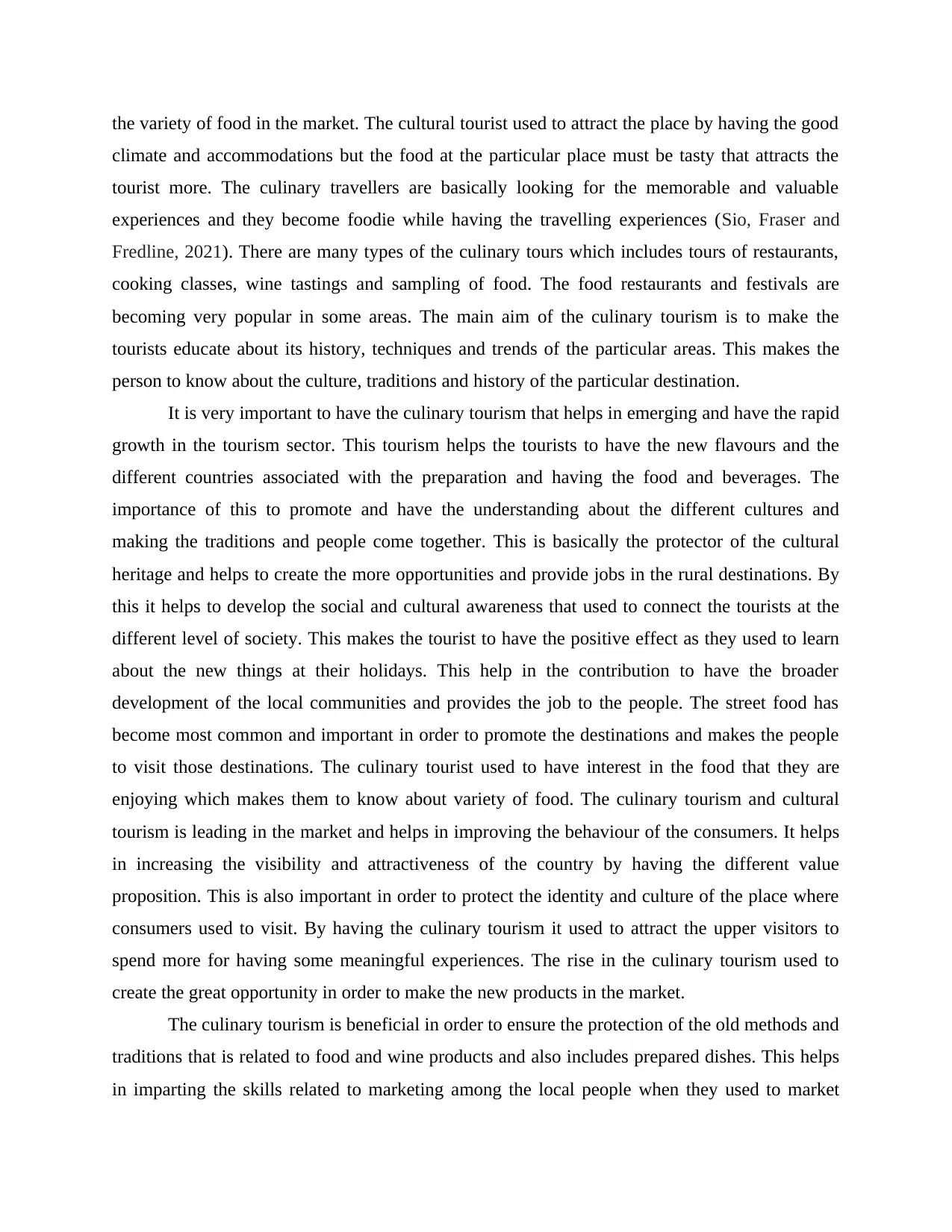
the variety of food in the market. The cultural tourist used to attract the place by having the good
climate and accommodations but the food at the particular place must be tasty that attracts the
tourist more. The culinary travellers are basically looking for the memorable and valuable
experiences and they become foodie while having the travelling experiences (Sio, Fraser and
Fredline, 2021). There are many types of the culinary tours which includes tours of restaurants,
cooking classes, wine tastings and sampling of food. The food restaurants and festivals are
becoming very popular in some areas. The main aim of the culinary tourism is to make the
tourists educate about its history, techniques and trends of the particular areas. This makes the
person to know about the culture, traditions and history of the particular destination.
It is very important to have the culinary tourism that helps in emerging and have the rapid
growth in the tourism sector. This tourism helps the tourists to have the new flavours and the
different countries associated with the preparation and having the food and beverages. The
importance of this to promote and have the understanding about the different cultures and
making the traditions and people come together. This is basically the protector of the cultural
heritage and helps to create the more opportunities and provide jobs in the rural destinations. By
this it helps to develop the social and cultural awareness that used to connect the tourists at the
different level of society. This makes the tourist to have the positive effect as they used to learn
about the new things at their holidays. This help in the contribution to have the broader
development of the local communities and provides the job to the people. The street food has
become most common and important in order to promote the destinations and makes the people
to visit those destinations. The culinary tourist used to have interest in the food that they are
enjoying which makes them to know about variety of food. The culinary tourism and cultural
tourism is leading in the market and helps in improving the behaviour of the consumers. It helps
in increasing the visibility and attractiveness of the country by having the different value
proposition. This is also important in order to protect the identity and culture of the place where
consumers used to visit. By having the culinary tourism it used to attract the upper visitors to
spend more for having some meaningful experiences. The rise in the culinary tourism used to
create the great opportunity in order to make the new products in the market.
The culinary tourism is beneficial in order to ensure the protection of the old methods and
traditions that is related to food and wine products and also includes prepared dishes. This helps
in imparting the skills related to marketing among the local people when they used to market
climate and accommodations but the food at the particular place must be tasty that attracts the
tourist more. The culinary travellers are basically looking for the memorable and valuable
experiences and they become foodie while having the travelling experiences (Sio, Fraser and
Fredline, 2021). There are many types of the culinary tours which includes tours of restaurants,
cooking classes, wine tastings and sampling of food. The food restaurants and festivals are
becoming very popular in some areas. The main aim of the culinary tourism is to make the
tourists educate about its history, techniques and trends of the particular areas. This makes the
person to know about the culture, traditions and history of the particular destination.
It is very important to have the culinary tourism that helps in emerging and have the rapid
growth in the tourism sector. This tourism helps the tourists to have the new flavours and the
different countries associated with the preparation and having the food and beverages. The
importance of this to promote and have the understanding about the different cultures and
making the traditions and people come together. This is basically the protector of the cultural
heritage and helps to create the more opportunities and provide jobs in the rural destinations. By
this it helps to develop the social and cultural awareness that used to connect the tourists at the
different level of society. This makes the tourist to have the positive effect as they used to learn
about the new things at their holidays. This help in the contribution to have the broader
development of the local communities and provides the job to the people. The street food has
become most common and important in order to promote the destinations and makes the people
to visit those destinations. The culinary tourist used to have interest in the food that they are
enjoying which makes them to know about variety of food. The culinary tourism and cultural
tourism is leading in the market and helps in improving the behaviour of the consumers. It helps
in increasing the visibility and attractiveness of the country by having the different value
proposition. This is also important in order to protect the identity and culture of the place where
consumers used to visit. By having the culinary tourism it used to attract the upper visitors to
spend more for having some meaningful experiences. The rise in the culinary tourism used to
create the great opportunity in order to make the new products in the market.
The culinary tourism is beneficial in order to ensure the protection of the old methods and
traditions that is related to food and wine products and also includes prepared dishes. This helps
in imparting the skills related to marketing among the local people when they used to market
Paraphrase This Document
Need a fresh take? Get an instant paraphrase of this document with our AI Paraphraser
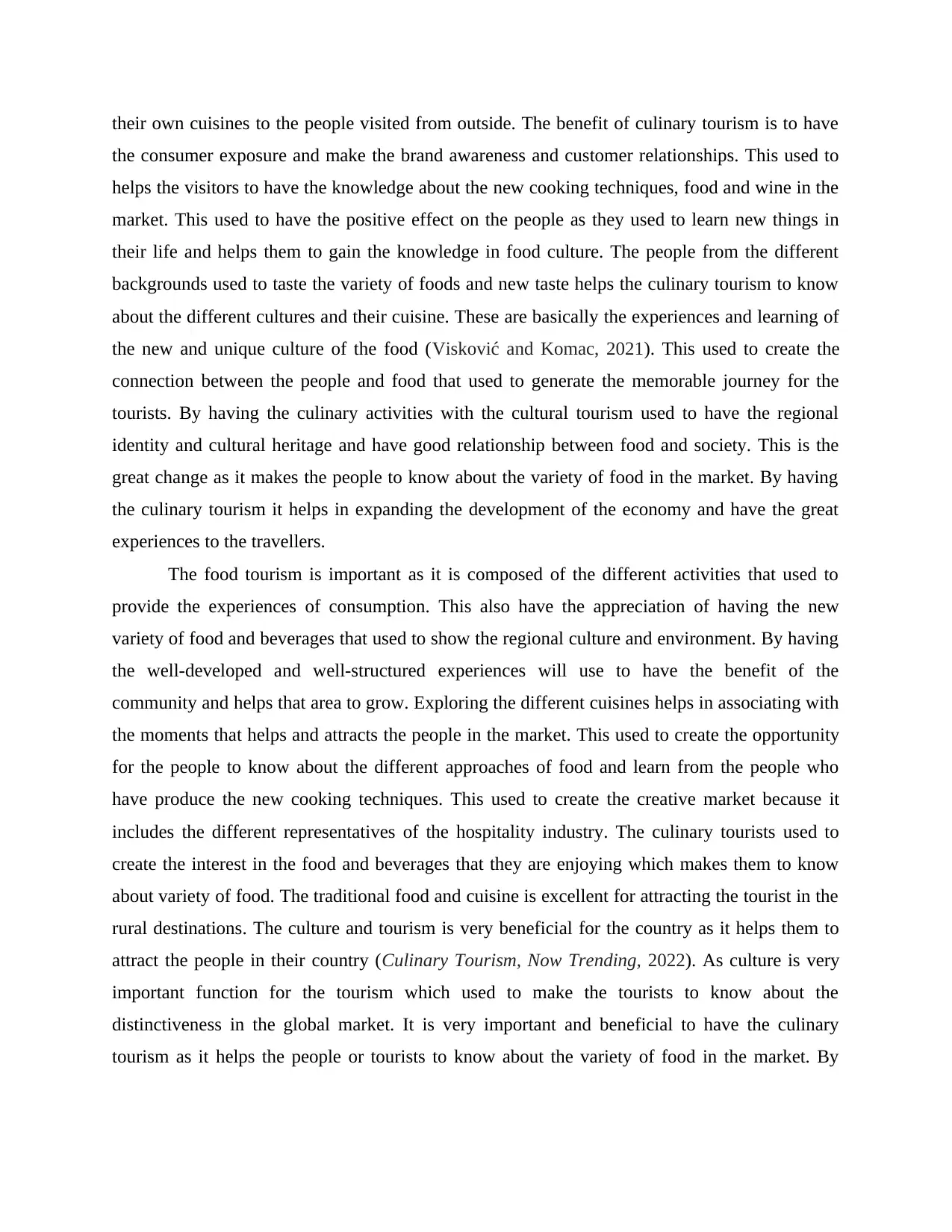
their own cuisines to the people visited from outside. The benefit of culinary tourism is to have
the consumer exposure and make the brand awareness and customer relationships. This used to
helps the visitors to have the knowledge about the new cooking techniques, food and wine in the
market. This used to have the positive effect on the people as they used to learn new things in
their life and helps them to gain the knowledge in food culture. The people from the different
backgrounds used to taste the variety of foods and new taste helps the culinary tourism to know
about the different cultures and their cuisine. These are basically the experiences and learning of
the new and unique culture of the food (Visković and Komac, 2021). This used to create the
connection between the people and food that used to generate the memorable journey for the
tourists. By having the culinary activities with the cultural tourism used to have the regional
identity and cultural heritage and have good relationship between food and society. This is the
great change as it makes the people to know about the variety of food in the market. By having
the culinary tourism it helps in expanding the development of the economy and have the great
experiences to the travellers.
The food tourism is important as it is composed of the different activities that used to
provide the experiences of consumption. This also have the appreciation of having the new
variety of food and beverages that used to show the regional culture and environment. By having
the well-developed and well-structured experiences will use to have the benefit of the
community and helps that area to grow. Exploring the different cuisines helps in associating with
the moments that helps and attracts the people in the market. This used to create the opportunity
for the people to know about the different approaches of food and learn from the people who
have produce the new cooking techniques. This used to create the creative market because it
includes the different representatives of the hospitality industry. The culinary tourists used to
create the interest in the food and beverages that they are enjoying which makes them to know
about variety of food. The traditional food and cuisine is excellent for attracting the tourist in the
rural destinations. The culture and tourism is very beneficial for the country as it helps them to
attract the people in their country (Culinary Tourism, Now Trending, 2022). As culture is very
important function for the tourism which used to make the tourists to know about the
distinctiveness in the global market. It is very important and beneficial to have the culinary
tourism as it helps the people or tourists to know about the variety of food in the market. By
the consumer exposure and make the brand awareness and customer relationships. This used to
helps the visitors to have the knowledge about the new cooking techniques, food and wine in the
market. This used to have the positive effect on the people as they used to learn new things in
their life and helps them to gain the knowledge in food culture. The people from the different
backgrounds used to taste the variety of foods and new taste helps the culinary tourism to know
about the different cultures and their cuisine. These are basically the experiences and learning of
the new and unique culture of the food (Visković and Komac, 2021). This used to create the
connection between the people and food that used to generate the memorable journey for the
tourists. By having the culinary activities with the cultural tourism used to have the regional
identity and cultural heritage and have good relationship between food and society. This is the
great change as it makes the people to know about the variety of food in the market. By having
the culinary tourism it helps in expanding the development of the economy and have the great
experiences to the travellers.
The food tourism is important as it is composed of the different activities that used to
provide the experiences of consumption. This also have the appreciation of having the new
variety of food and beverages that used to show the regional culture and environment. By having
the well-developed and well-structured experiences will use to have the benefit of the
community and helps that area to grow. Exploring the different cuisines helps in associating with
the moments that helps and attracts the people in the market. This used to create the opportunity
for the people to know about the different approaches of food and learn from the people who
have produce the new cooking techniques. This used to create the creative market because it
includes the different representatives of the hospitality industry. The culinary tourists used to
create the interest in the food and beverages that they are enjoying which makes them to know
about variety of food. The traditional food and cuisine is excellent for attracting the tourist in the
rural destinations. The culture and tourism is very beneficial for the country as it helps them to
attract the people in their country (Culinary Tourism, Now Trending, 2022). As culture is very
important function for the tourism which used to make the tourists to know about the
distinctiveness in the global market. It is very important and beneficial to have the culinary
tourism as it helps the people or tourists to know about the variety of food in the market. By
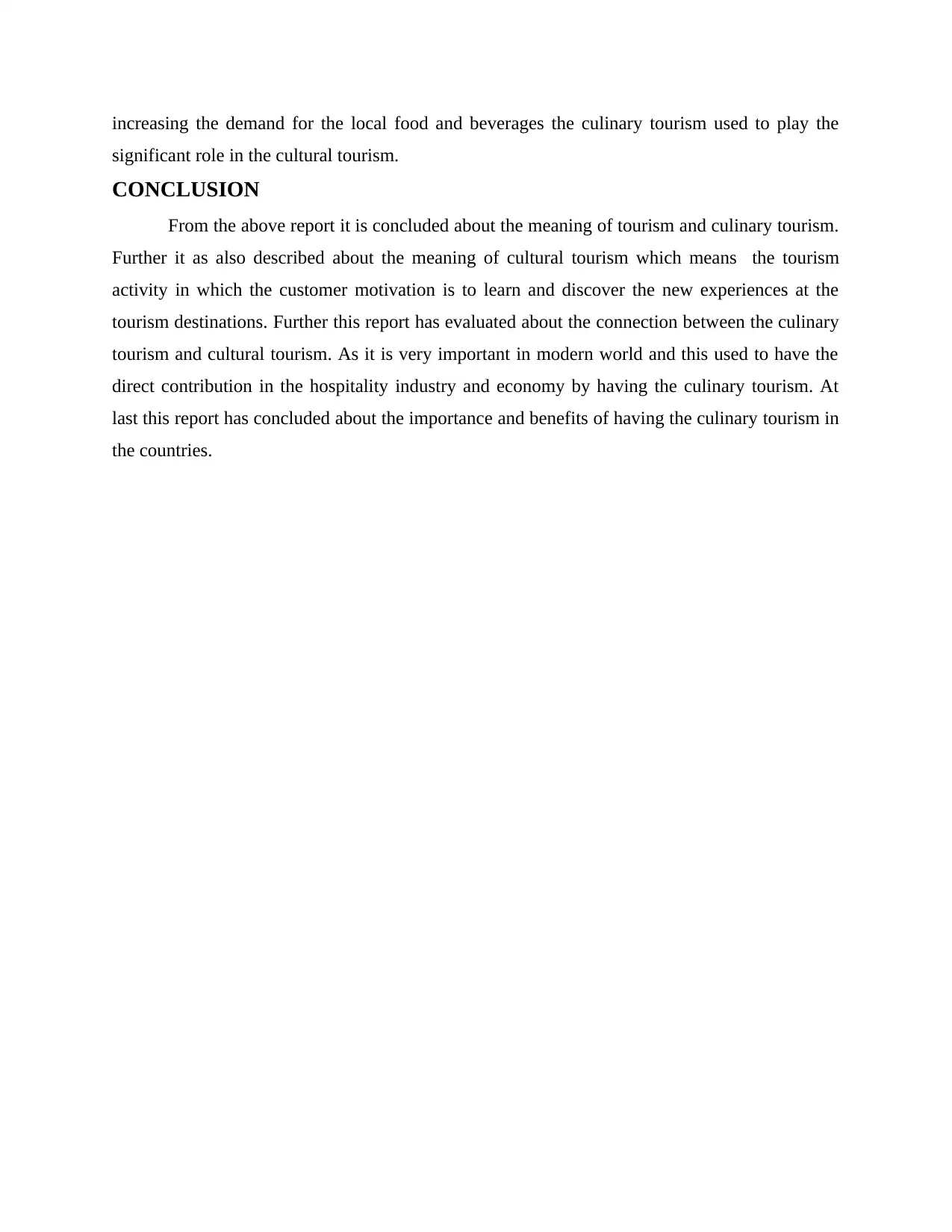
increasing the demand for the local food and beverages the culinary tourism used to play the
significant role in the cultural tourism.
CONCLUSION
From the above report it is concluded about the meaning of tourism and culinary tourism.
Further it as also described about the meaning of cultural tourism which means the tourism
activity in which the customer motivation is to learn and discover the new experiences at the
tourism destinations. Further this report has evaluated about the connection between the culinary
tourism and cultural tourism. As it is very important in modern world and this used to have the
direct contribution in the hospitality industry and economy by having the culinary tourism. At
last this report has concluded about the importance and benefits of having the culinary tourism in
the countries.
significant role in the cultural tourism.
CONCLUSION
From the above report it is concluded about the meaning of tourism and culinary tourism.
Further it as also described about the meaning of cultural tourism which means the tourism
activity in which the customer motivation is to learn and discover the new experiences at the
tourism destinations. Further this report has evaluated about the connection between the culinary
tourism and cultural tourism. As it is very important in modern world and this used to have the
direct contribution in the hospitality industry and economy by having the culinary tourism. At
last this report has concluded about the importance and benefits of having the culinary tourism in
the countries.
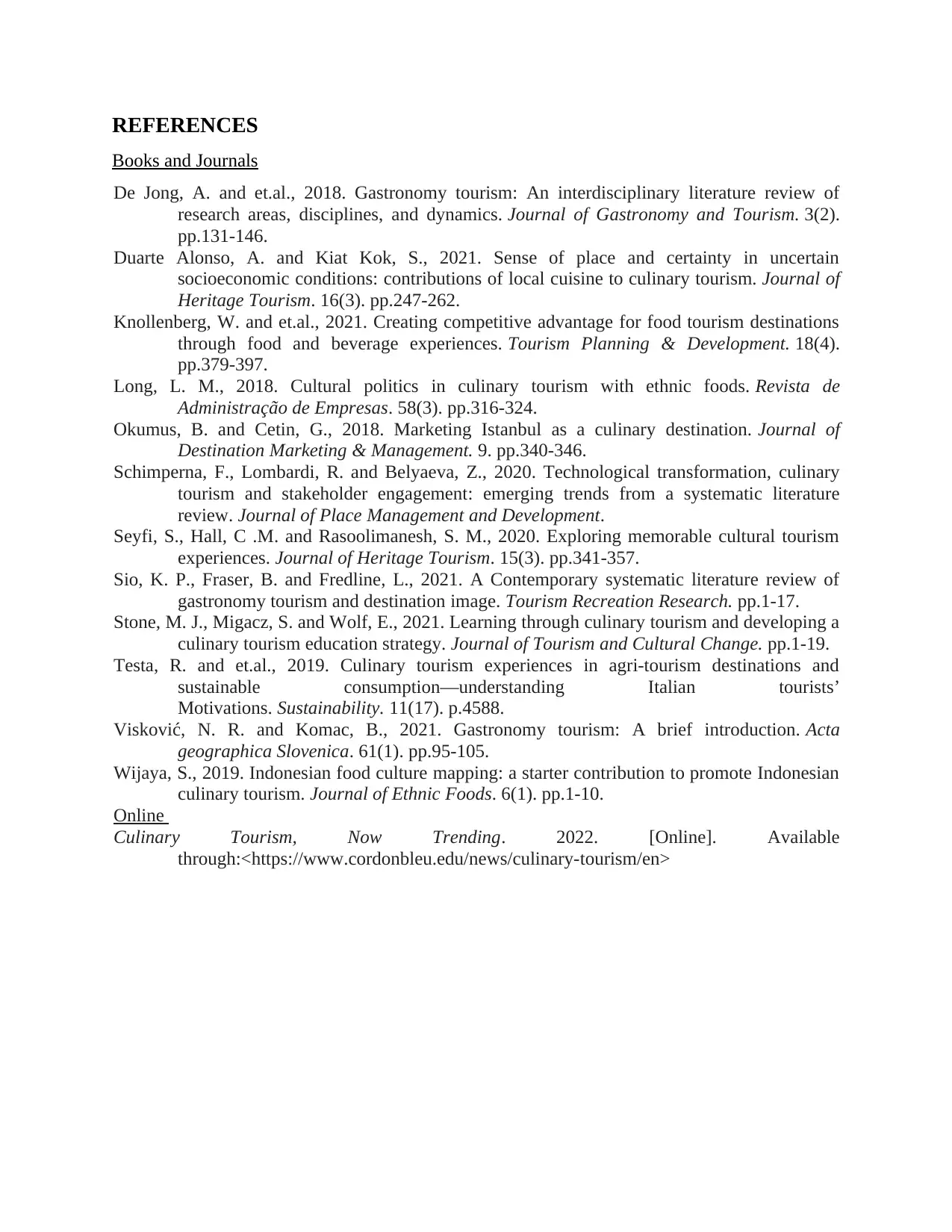
REFERENCES
Books and Journals
De Jong, A. and et.al., 2018. Gastronomy tourism: An interdisciplinary literature review of
research areas, disciplines, and dynamics. Journal of Gastronomy and Tourism. 3(2).
pp.131-146.
Duarte Alonso, A. and Kiat Kok, S., 2021. Sense of place and certainty in uncertain
socioeconomic conditions: contributions of local cuisine to culinary tourism. Journal of
Heritage Tourism. 16(3). pp.247-262.
Knollenberg, W. and et.al., 2021. Creating competitive advantage for food tourism destinations
through food and beverage experiences. Tourism Planning & Development. 18(4).
pp.379-397.
Long, L. M., 2018. Cultural politics in culinary tourism with ethnic foods. Revista de
Administração de Empresas. 58(3). pp.316-324.
Okumus, B. and Cetin, G., 2018. Marketing Istanbul as a culinary destination. Journal of
Destination Marketing & Management. 9. pp.340-346.
Schimperna, F., Lombardi, R. and Belyaeva, Z., 2020. Technological transformation, culinary
tourism and stakeholder engagement: emerging trends from a systematic literature
review. Journal of Place Management and Development.
Seyfi, S., Hall, C .M. and Rasoolimanesh, S. M., 2020. Exploring memorable cultural tourism
experiences. Journal of Heritage Tourism. 15(3). pp.341-357.
Sio, K. P., Fraser, B. and Fredline, L., 2021. A Contemporary systematic literature review of
gastronomy tourism and destination image. Tourism Recreation Research. pp.1-17.
Stone, M. J., Migacz, S. and Wolf, E., 2021. Learning through culinary tourism and developing a
culinary tourism education strategy. Journal of Tourism and Cultural Change. pp.1-19.
Testa, R. and et.al., 2019. Culinary tourism experiences in agri-tourism destinations and
sustainable consumption—understanding Italian tourists’
Motivations. Sustainability. 11(17). p.4588.
Visković, N. R. and Komac, B., 2021. Gastronomy tourism: A brief introduction. Acta
geographica Slovenica. 61(1). pp.95-105.
Wijaya, S., 2019. Indonesian food culture mapping: a starter contribution to promote Indonesian
culinary tourism. Journal of Ethnic Foods. 6(1). pp.1-10.
Online
Culinary Tourism, Now Trending. 2022. [Online]. Available
through:<https://www.cordonbleu.edu/news/culinary-tourism/en>
Books and Journals
De Jong, A. and et.al., 2018. Gastronomy tourism: An interdisciplinary literature review of
research areas, disciplines, and dynamics. Journal of Gastronomy and Tourism. 3(2).
pp.131-146.
Duarte Alonso, A. and Kiat Kok, S., 2021. Sense of place and certainty in uncertain
socioeconomic conditions: contributions of local cuisine to culinary tourism. Journal of
Heritage Tourism. 16(3). pp.247-262.
Knollenberg, W. and et.al., 2021. Creating competitive advantage for food tourism destinations
through food and beverage experiences. Tourism Planning & Development. 18(4).
pp.379-397.
Long, L. M., 2018. Cultural politics in culinary tourism with ethnic foods. Revista de
Administração de Empresas. 58(3). pp.316-324.
Okumus, B. and Cetin, G., 2018. Marketing Istanbul as a culinary destination. Journal of
Destination Marketing & Management. 9. pp.340-346.
Schimperna, F., Lombardi, R. and Belyaeva, Z., 2020. Technological transformation, culinary
tourism and stakeholder engagement: emerging trends from a systematic literature
review. Journal of Place Management and Development.
Seyfi, S., Hall, C .M. and Rasoolimanesh, S. M., 2020. Exploring memorable cultural tourism
experiences. Journal of Heritage Tourism. 15(3). pp.341-357.
Sio, K. P., Fraser, B. and Fredline, L., 2021. A Contemporary systematic literature review of
gastronomy tourism and destination image. Tourism Recreation Research. pp.1-17.
Stone, M. J., Migacz, S. and Wolf, E., 2021. Learning through culinary tourism and developing a
culinary tourism education strategy. Journal of Tourism and Cultural Change. pp.1-19.
Testa, R. and et.al., 2019. Culinary tourism experiences in agri-tourism destinations and
sustainable consumption—understanding Italian tourists’
Motivations. Sustainability. 11(17). p.4588.
Visković, N. R. and Komac, B., 2021. Gastronomy tourism: A brief introduction. Acta
geographica Slovenica. 61(1). pp.95-105.
Wijaya, S., 2019. Indonesian food culture mapping: a starter contribution to promote Indonesian
culinary tourism. Journal of Ethnic Foods. 6(1). pp.1-10.
Online
Culinary Tourism, Now Trending. 2022. [Online]. Available
through:<https://www.cordonbleu.edu/news/culinary-tourism/en>
1 out of 10
Related Documents
Your All-in-One AI-Powered Toolkit for Academic Success.
+13062052269
info@desklib.com
Available 24*7 on WhatsApp / Email
![[object Object]](/_next/static/media/star-bottom.7253800d.svg)
Unlock your academic potential
© 2024 | Zucol Services PVT LTD | All rights reserved.





